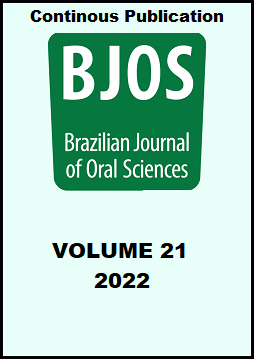Abstract
Aim: This study aimed to evaluate the effect of frozen storage on the physical properties of a silicone-based test food material, highly used to evaluate the masticatory performance in research settings. Methods: A total of 1,666 silicone cubes of Optosil Comfort® with 5.6-mm edges were shaped and stored at -18°C. The cubes were subsequently tested for flexural strength (maximum force, displacement, stress, and strain) before breaking (n = 136), changes in weight and size (n = 170), and masticatory performance (n = 1360) at eight timepoints: immediately after cube preparation (baseline, no freezing), and 1, 2, 3 and 4 weeks, and 2, 4 and 6 months after frozen storage. The cubes were thawed 8 h before each assessment. Results: The maximum force, stress, maximum displacement, and deformation values for the cubes were not affected by freezing (P > 0.05). At all of the time points, the cubes exhibited similar weight (P = 0.366) and size (identical values). The masticatory performance for the cubes also showed no differences from baseline through 6 months (P = 0.061). Conclusion: Freezing Optosil Comfort® silicone cubes did not alter the physical and mechanical properties of the material, being suitable to optimize the assessment of masticatory parameters for research purposes.
References
van der Glas HW, Al-Ibrahim A, Lyons MF. A stable artificial test food suitable for labeling to quantify selection and breakage in subjects with impaired chewing ability. J Texture Stud. 2012;43(4):287-98. doi: 10.1111/j.1745-4603.2011.00344.x
Gonçalves TMSV, Schimmel M, van der Bilt A, Chen J, van der Glas HW, Kohyama K, et al. Consensus on the terminologies and methodologies for masticatory assessment. J Oral Rehabil. 2021 Jun;48(6):745-61. doi: 10.1111/joor.13161.
Sánchez-Ayala A, Vilanova LS, Costa MA, Farias-Neto A. Reproducibility of a silicone-based test food to masticatory performance evaluation by different sieve methods. Braz Oral Res. 2014;28:S1806-83242014000100226. doi: 10.1590/1807-3107bor-2014.vol28.0004.
Slagter AP, Bosman F, Van der Bilt A. Comminution of two artificial test foods by dentate and edentulous subjects. J Oral Rehabil. 1993 Mar;20(2):159-76. doi: 10.1111/j.1365-2842.1993.tb01599.x.
Lucas PW, Luke DA. Optimum mouthful for food comminution in human mastication. Arch Oral Biol. 1984;29(3):205-10. doi: 10.1016/0003-9969(84)90056-6.
Sanchez-Ayala A, Ambrosano GM, Rodrigues Garcia RC. Influence of length of occlusal support on masticatory function of free-end removable partial dentures. Int J Prosthodont. 2012 Sep-Oct;25(5):472-9.
Campos SS, Pereira CV, Zangerônimo MG, Marques LS, Pereira LJ. Influence of disinfectant solutions on test materials used for the determination of masticatory performance. Braz Oral Res. 2013;27(3):238-44. doi: 10.1590/S1806-83242013005000013.
Albert TE, Buschang PH, Throckmorton GS. Masticatory performance: a protocol for standardized production of an artificial test food. J Oral Rehabil. 2003 Jul;30(7):720-2. doi: 10.1046/j.1365-2842.2003.01155.x.
Pereira LJ, van der Bilt A. The influence of oral processing, food perception and social aspects on food consumption: a review. J Oral Rehabil. 2016 Aug;43(8):630-48. doi: 10.1111/joor.12395.
Mazurek P, Vudayagiri S, Skov AL. How to tailor flexible silicone elastomers with mechanical integrity: a tutorial review. Chem Soc Rev. 2019 Mar 18;48(6):1448-64. doi: 10.1039/c8cs00963e.
Sánchez-Ayala A, Farias-Neto A, Campanha NH, Garcia RC. Relationship between chewing rate and masticatory performance. Cranio. 2013 Apr;31(2):118-22. doi: 10.1179/crn.2013.019.
Carlo HL, Fonseca RB, Soares CJ, Correr AB, Correr-Sobrinho L, Sinhoreti MA. Inorganic particle analysis of dental impression elastomers. Braz Dent J. 2010;21(6):520-7. doi: 10.1590/s0103-64402010000600007.
Sluyters JH, Sluyters-Rehbach M. Deviation from van't hoff behavior of solids at low temperature. ACS Omega. 2017 May 31;2(5):2317-25. doi: 10.1021/acsomega.7b00169.
Arvidson K, Johansson EG. The freezing-effect on the dimensional stability of impression materials. Swed Dent J. 1978;2(2):61-5.
Silva SM, Salvador MC. Effect of the disinfection technique on the linear dimensional stability of dental impression materials. J Appl Oral Sci. 2004 Sep;12(3):244-9. doi: 10.1590/s1678-77572004000300016.
Liénard, R, De Winter, J, Coulembier, O. Cyclic polymers: Advances in their synthesis, properties, and biomedical applications. J Polym Sci. 2020;58:1481-502. doi:10.1002/pol.20200236.
Horodecka S, Strachota A, Mossety-Leszczak B, Strachota B, Šlouf M, Zhigunov A, et al. Low-Temperature Meltable Elastomers Based on Linear Polydimethylsiloxane Chains Alpha, Omega-Terminated with Mesogenic Groups as Physical Crosslinkers: A Passive Smart Material with Potential as Viscoelastic Coupling. Part I: Synthesis and Phase Behavior. Polymers (Basel). 2020 Oct 25;12(11):2476. doi: 10.3390/polym12112476.
Kondratyuk R. Determination of the lower limit of the working temperatures of silicone elastomers for the manufacture of electronics products. Vector High Technol. 2013;4:52-7.
Bezdomnikov AA, Emel’yanenko AM, Emel’yanenko KA, Boinovich LB. Delay in the freezing of supercooled water drops on superhydrophobic surfaces of silicone rubber at negative temperatures. Russ J Phys Chem. 2018;92:178-84. doi: 10.1134/S0036024418010077.
Xiang K, Huang G, Zheng J, Wang X, xian Li G, Huang J. Accelerated thermal ageing studies of polydimethylsiloxane (PDMS) rubber. J Polym Res. 2012 May;19(5):9869-75. doi: 10.1007/s10965-012-9869-6..
Colin X, Audouin L, Verdu J. Kinetic modelling of the thermal oxidation of polyisoprene elastomers. Part 3: Oxidation induced changes of elastic properties. Polym Degrad Stab. 2007;92:906-14. doi: 10.1016/J.POLYMDEGRADSTAB.2007.01.013.
Papadogiannis D, Lakes R, Palaghias G, Papadogiannis Y. Effect of storage time on the viscoelastic properties of elastomeric impression materials. J Prosthodont Res. 2012 Jan;56(1):11-8. doi: 10.1016/j.jpor.2011.03.002.
Lewicki JP, Liggat JJ, Patel M. The thermal degradation behaviour of polydimethylsiloxane/montmorillonite nanocomposites. Polym Degrad Stab. 2009 Sep;94(9):1548-57. doi: 10.1016/j.polymdegradstab.2009.04.030.
van der Glas HW, Liu T, Zhang Y, Wang X, Chen J. Optimizing a determination of chewing efficiency using a solid test food. J Texture Stud. 2020 Feb;51(1):169-84. doi: 10.1111/jtxs.12477.
Liu T, Wang X, Chen J, van der Glas HW. Determining chewing efficiency using a solid test food and considering all phases of mastication. Arch Oral Biol. 2018 Jul;91:63-77. doi: 10.1016/j.archoralbio.2018.04.002.
Elgestad Stjernfeldt P, Sjögren P, Wårdh I, Boström AM. Systematic review of measurement properties of methods for objectively assessing masticatory performance. Clin Exp Dent Res. 2019 Jan 31;5(1):76-104. doi: 10.1002/cre2.154.

This work is licensed under a Creative Commons Attribution 4.0 International License.
Copyright (c) 2021 Brazilian Journal of Oral Sciences


